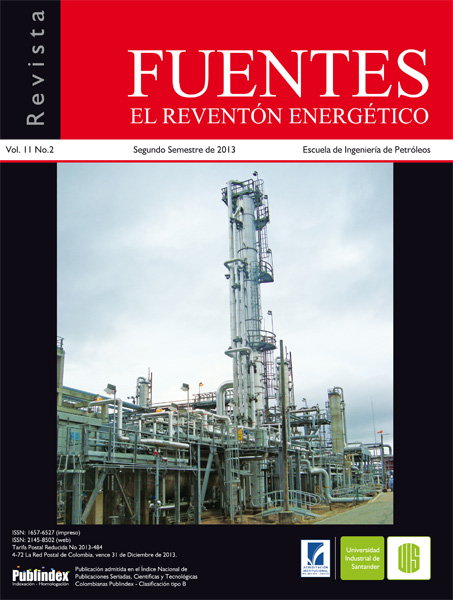Constructed wetland design for produced water treatment on a colombian petroleum field
Published 2013-12-23
Keywords
- Petroleum wastewater,
- produced water treatment,
- constructed wetlands,
- environment
How to Cite
Abstract
The development of this paper permits to find and set a new and alternative solution to the big problem that Colombian petroleum fields are facing: Management and Disposal of produced water. Due to the conventional treatment facilities, petroleum companies are spending great amounts of money to treat and dispose petroleum wastewaters. The present project describes a full-scale constructed wetland design proposed as a secondary treatment for a Colombian field produced water.
The design takes into account the physicochemical characteristics of a Colombian field water affluent, represented as organic matter (BOD) and Total Suspended Solids (TSS) oncentrations, according to the main design criteria for the technology, like type and ollutants concentrations, type of wetland, entrance water rate and total area required. Once the type of wetland is selected, the design realizes the principal constraints that affect wetland performance, including operational and maintenance procedures for a future implementation. The design consists in a Horizontal Subsurface flow Constructed Wetland (HSSf CW) with 12 ha of superficial area and 2 ft depth, to treat an average water rate of 678.607 Bbl/day. The HSSf CW consisted on 60 cells of 109,35 x 196,85 ft each, organized in parallel (12) and in series (5). Each cell will be planted with native aquatic macrophytes to enhance purification processes. This grand superficial area design is considered compensated by the low operational and maintenance costs, calculated for a 10-year period. While a conventional treatment system for produced water needs an inversion of US$4.380.338,1 per year, a HSSF CW works with US$23.681,78 for the same time period.
Downloads
References
2. aRnOLD, R., BuRnETT, D.B., ELPHiCK, J., fEELEY, T.J., GaLBRun, M., HiGHTOWER, M., JianG, Z., KHan, M., LavERY, M., LuffEY, f. & vERBEEK, P. Managing water. Schlumberger. En: Schlumberger. En: http://www.slb.com/~/media/Files/resources/oilfield_review/ors04/sum04/04_managing_water.pdf.[citado en 2004].
3. ECOPETROL S.a 2012.
4. LAWRENCE, A.W., MILLER, J.A., MILLER, D.L., Remediation Technologies inc.; LinZ, D.G., Gas Research Inst. An Evaluation of Produced Water Management options in the Natural Gas Production Industry. 1993.
5. LARS H. H., Maersk Oil. Produced Water Management in Mature Field Operation. 2009.
6. Y. Du, new Mexico Tech; L. Guan, Texas; H. LIANG, China Petroleum University. Advances of Produced Water Management. 2005.
7. P. EVANS, K. ROBINSON, Oil Plus Limited Produced Water Management. Reservoir and Facilities Engineering Aspects. 1999.
8. E.D. WALLACE, Alberta Research Council; J. ZHOu, alberta Research Council; C. MaTTHEWS, C-fER Technologies Limited; E. HOffMan, Consultant. WaTER ManaGEMEnT in THE OiL PRODuCTiOn inDuSTRY. 2000.
9. aRnOLD, K. & STEWaRT, M. Surface Production Operations. 3 ed. Houston: ElSEVIER, 2008.
10. MOnTES, E. Tecnologías de Tratamiento de Emulsiones en Campos Petroleros. Tesis de Especialización. 2010.
11. Asociación Regional de Empresas del sector Petróleo, gas y biocombustibles en Latinoamérica y el Caribe. ARPEL. Disposición y tratamiento del agua producida. 1992.
12. Ministerio de medio ambiente y desarrollo sostenible. Decreto 4728 de 2010. En: http://www.minambiente.gov.co. [Revisión 5.0, Octubre, 2012].
13. JaCKSOn, L.M. y MYERS, J.E. Design and Construction of Pilot Wetlands for Produced-Water Treatment. SPE 84587-MS. 5-8 Octubre 2003. En: Onepetro [base de datos en línea].
14. M.G. PUDER, Loyola University, and J.A. VEIL, SPE, Argonne National Laboratory. Options, Methods, and Costs for Offsite Commercial Disposal of Exploration and Production Wastes. 2007.
